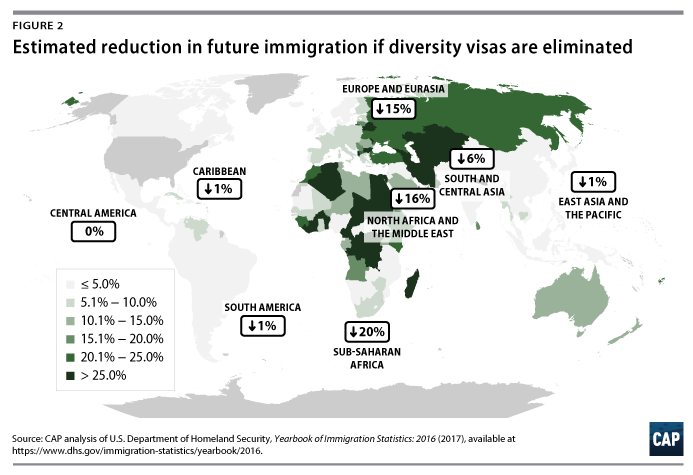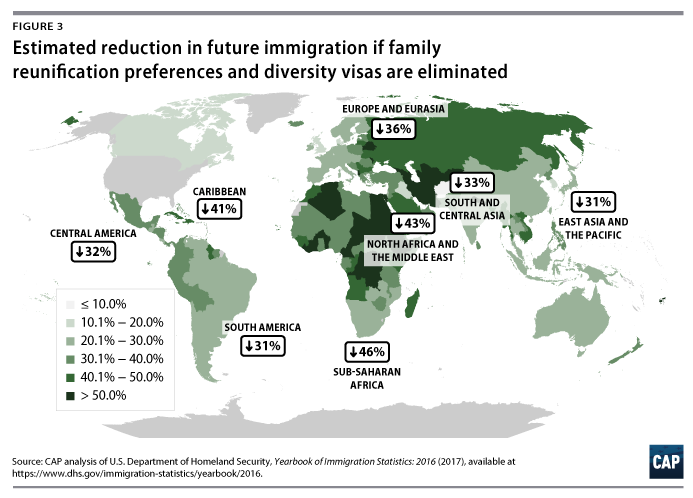President Donald Trump’s persistent efforts to slash future immigration to the United States are rooted in lies that can’t pass the fact checkers. Under the guise of “protect[ing] the nuclear family,” Trump proposed eliminating the ability of U.S. citizens to reunite with their parents and siblings, and the ability of U.S. citizens and lawful permanent residents to reunite with their adult children. He has also claimed that people who apply for the diversity visa program—which makes 50,000 visas available each year to people from countries that send few immigrants to the United States—“are the worst of the worst.”
This week, the Senate will take up debate on legalization for Dreamers. In advance of that effort, the White House is doubling down on its framework to make substantial cuts to future legal immigration, including curtailing family migration and eliminating the diversity visa program. This approach is antithetical to the issue at hand: protecting Dreamers. Members of both parties have been calling for a narrow, bipartisan bill that pairs protections for Dreamers with additional border security, but the Trump administration’s approach goes far beyond this. Moreover, by eliminating entire categories of legal immigration to the country, the White House framework also flies in the face of what many conservatives in Congress have been saying for years—that they are against illegal immigration but in favor of legal immigration.
The Trump administration’s proposed changes to the U.S. immigration system are not only discordant with bipartisan policy goals, but they are also radical and destructive. The cuts to family reunification and the diversity visa program alone would reduce the future immigration flow by 35 percent. They would deny immigration for more than 350,000 people each year and bar people from all around the world from uniting with their family members in the United States.
This column identifies the countries, mostly in Latin America, Africa, and Asia, that would be most impacted by each change.
Family reunification is the foundation of the U.S. immigration system. Approximately two-thirds of the people receiving immigrant visas in 2016 received family reunification visas. There are four types of family sponsored preferences:
- Unmarried adult sons and daughters of U.S. citizens and their children
- Spouses, children, and unmarried adult sons and daughters of lawful permanent residents
- Married adult sons and daughters of U.S. citizens and their spouses and children
- Brothers and sisters of adult U.S. citizens and their spouses and children
Around 226,000 individuals from these preferences are granted visas each year. Immediate relatives of U.S. citizens, which include spouses, minor children, and parents, are considered a separate category of family sponsored preferences and not subject to a numeric limit.
The White House framework proposes eliminating all of these visa categories, save for the spouses and minor children of U.S. citizens and lawful permanent residents. The framework, which has been adapted by Sen. Chuck Grassley (R-IA) into the Secure and Succeed Act of 2018, has yet to be introduced and thus we do not know precisely how it will function.
The framework proposes ending the diversity visa program, which currently makes 50,000 visas available each year to immigrants from countries with low immigration to the United States. In 2015, 14.4 million people entered the lottery for the chance to apply for the 50,000 visas. President Trump claimed that countries “put names in a hopper. They’re not giving you their best names. … They’re giving you people they don’t want.” But to be eligible for the diversity visa, an individual must have a high school diploma or have two years of work experience in a specialized occupation, pass a background check, and undergo consular interviews. Immigrants who come to the United States through family reunification and the diversity visa program are generally highly skilled, and are more likely than the native-born to hold a bachelor’s or advanced degree; nearly one-quarter of immigrants who enter on the diversity visa work in management, professional, and related occupations.
Last month the Center for Global Development (CGD) published estimates of how the White House framework, operationalized through a bill like the Securing America’s Future Act, would change U.S. immigration. Eliminating the proposed family migration categories and the diversity visa would disproportionately impact black and Hispanic immigrants, resulting in declines of 64 and 58 percent, respectively. In addition, it would halve the flow of Catholic, Muslim, and Orthodox Christian immigrants, with declines of 54 percent, 53 percent, and 49 percent, respectively.
Using the Department of Homeland Security’s “2016 Yearbook of Immigration Statistics” and the White House framework, Center for American Progress quantifies the consequences of restricted immigration channels by country and region of the world. The proposed changes would be prospective; the maps below illustrate what can be expected whenever these cuts would take effect.

Eliminating entire categories of legal immigration that permit people to reunite with their families in the United States would result in 307,000 fewer immigrants each year. The countries that would bear the largest brunt are: Mexico (56,000); the Dominican Republic (26,000); China, (19,000); and Vietnam, India, and the Philippines (all 18,000). Future immigration flows would drop by at least 30 percent for the Caribbean, Central America, East Asia and the Pacific, and South America.

Ending the diversity visa would restrict the ability for individuals from sub-Saharan Africa, Europe and Eurasia, and North Africa and the Middle East, in particular, to come to the United States. In 2016, the five countries with the most diversity visas were Egypt (3,500), Nepal (3,200), Iran (2,900), the Democratic Republic of the Congo (2,800), and Uzbekistan (2,500).

Combining the elimination of family migration paths and the entire diversity visa program, worldwide immigration flows would drop by at least 35 percent compared with 2016. The Caribbean, North Africa and the Middle East, and sub-Saharan Africa—regions largely coterminous with President Trump’s alleged recent tirade about immigration from “shithole countries”—would be the most severely affected.
In all, immigration would drop by more than 50 percent from 32 countries, and more than one-third from 106 countries.
Combined with efforts to raise the barriers to family reunification for to working-class immigrants and institute multiple Muslim and refugee Muslim and refugee bans by executive order, the Trump administration is deliberately chiseling away at the ability of certain people to enter the United States. Drastic cuts to our refugee resettlement program, reducing the target for resettlement from 110,000 refugees to a historic low of 45,000 similarly close the door to people seeking humanitarian protection in our country. The White House framework does not discuss changes to refugee and asylee admissions, thus they are excluded from the analysis. The extent of cuts would likely be greater if they were included.
Rather than “Make America Great Again,” the Trump administration’s immigration framework is really trying to make America white again. Congress shouldn’t take the bait. It should focus on the task at hand—protecting Dreamers—rather than remaking the entirety of American immigration policy.
Nicole Prchal Svajlenka is a senior policy analyst for Immigration Policy at the Center for American Progress.
Author’s note: Regions match the State Department definitions, with the exception of breakouts for what it labels the Western Hemisphere. This analysis creates separate regions for Central America (which includes Mexico), the Caribbean, and South America.